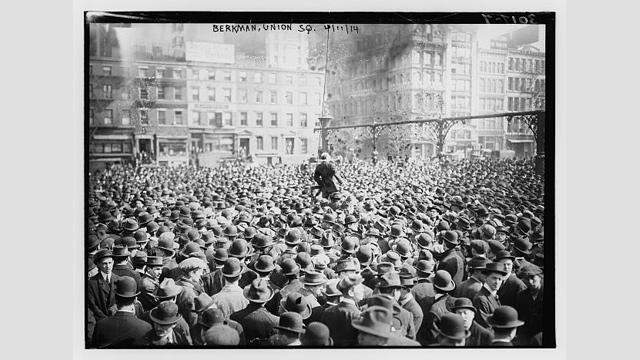
Photo: Walker & Company
Who is the real hero in Thai Jones’s history, "More Powerful than Dynamite: Radicals, Plutocrats, Progressives, and New York's Year of Anarchy"? It certainly isn’t dynamite, as the title of this book indicates. The superrich – J. D. Rockefeller and his son, “Junior,” as Jones refers to him - aren’t heroic either, but many of the radicals, such as Alexander Berkman, aren’t held up as paragons of revolutionary virtue either. A Russian-born anarchist, lover of Emma Goldman and many other women, Berkman tried to assassinate Henry Frick, the steel tycoon, and couldn’t shoot straight. Frick survived. Berkman was arrested, tried, found guilty, imprisoned, and released. By 1914, he was back on the streets of New York again, walking the radical walk and talking the radical talk all through “New York’s Year of Anarchy.”
Jones is the perfect, or near-perfect American historian to write about New York radicals and plutocrats. The son of New Leftists and the grandson of Old Leftists, he came of age in the American left, though he’s never accepted as gospel the tenets of the left. I’ve known him since he was a young man and have followed his education at Columbia. His mother, Eleanor Stein, and I were married from 1964 to 1977. I am not an objective reviewer, but I have aimed to be fair and accurate. As a student of the life and work of Jack London, and as the editor of "The Radical Jack London: Writings on War and Revolution," I am familiar with the historical period that Jones writes about. I’m an Old New Leftist myself and have written a biography of Abbie Hoffman entitled "For the Hell of It" that seems more relevant than ever before in light of the Occupy Wall Street movement.
"More Powerful Than Dynamite" recounts two biographies at once: the biography of a year and the biography of a city, the second largest in the world on the eve of World War I, with capitalism in crisis and communism haunting the capitals of the world. Jones tells his epic of New York in 1914 by offering dozens of beautifully crafted portraits of workers without work, anarchists in love with anarchy, reformers plotting reforms, and plutocrats calculating profits and ministering to their own public relations. With one eye on New York City and the American nation now, and another on the city and the nation nearly one hundred years ago, Jones reminds readers that history repeats itself again and again as tragedy, farce, the absurd and the irrelevant.
He reminds readers, too, that the incessant repetitions of history mean nothing at all unless historians lift them out of the obscurity to which they are consigned and magnify them for all the world to see. Jones made an astounding discovery while researching the history of New York in 1914.
Indeed, on July 4, 1914, three anarchists, terrorists, bomb-makers – call them what you will – blew themselves up in a Harlem tenement, and thus failed to carry out their plan to dynamite the estate of John D. Rockefeller, Jr. Their names are largely forgotten now: Arthur Caron, Carl Hanson, and Charles Berg. They were the political ancestors of three members of the Weather Underground - Ted Gold, Diana Oughton, and Terry Robbins - who blew themselves up in a Greenwich Village townhouse in March 1970.
Jones writes compassionately about Caron, Hanson, and Berg. He traces their movements in New York, outlines their ideas and values, but he does not linger too long over them. Rather, he places their individual stories in a larger, far more complex narrative about wealth and power, poverty and powerlessness in an America that seemed ready to blow itself up, and just might have if World War I hadn’t arrived on schedule - and if Woodrow Wilson hadn’t sent American troops to fight in Europe.
"More Powerful Than Dynamite" offers a gallery of stunning portraits of New Yorkers: Mayor John Purroy Mitchel; Chief-Inspector Max Schmittberger; Industrial Workers of the World icon Frank Tannenbaum; and Becky Edelsohn, orphan, anarchist extraordinarie, and lover of Alexander Berkman, who was arrested for calling “Junior” a “multi-murderer.” Jones brings all of these historical figures to life.
Jones tells his history as though he loves it, as though it really matters to him, and as though it ought to matter to us today. Readers who love "More Powerful Than Dynamite" have been saying that it’s “like a novel.” Indeed, it has all the pacing, suspense, and character development associated with those big European novels that take on an entire society. But it is also a work of American history at its best. It offers a story about the past told through the lens of the present.
It is timely, entertaining and uplifting, and it offers real heroes, too, such as Walter Lippmann, the phenomenal American journalist, reporter and artist of the daily newspaper, whose words from 1914 appear open Jones’s masterpiece:
“Patriotism, the Cause, Humanity, Perfection, Righteousness, Liberty – all of them large and windy abstractions to outsiders,” Lippmann wrote, “are more powerful than dynamite to those who feel them.”
Thai Jones will be discussing "More Powerful Than Dynamite" at a reading next Monday, April 23, in Room 523 at Columbia University's Butler Library. It starts at 6:30pm and is open to the public.
3 WAYS TO SHOW YOUR SUPPORT
- Log in to post comments











